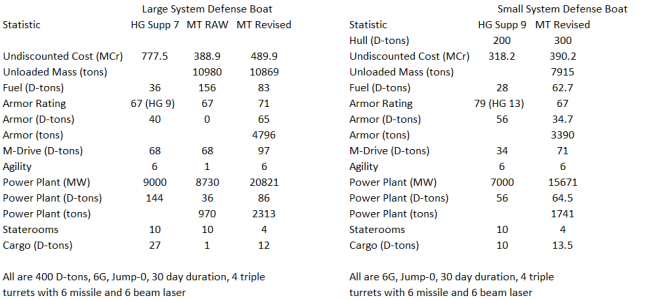Thanks for the SDB info, and as a reward, let's look at some SDBs! These are based upon the 400 D-ton from Supp7 and the 200 D-ton from Supp9, both designed with HG. There are some very interesting tradeoffs in these examples, so I'll be interested in any commentary. Remember to refer back to the OP for the assumptions I'm using in the MT Revised designs.

Let's start with the 400 D-ton (left). I was able to include the original MT RAW design from the Imperial Encyclopedia. My design is only MCr100 more, and I haven't gone all the way through the HG design to see why it's s expensive. Observations:
1) Notice the Fuel differences. MT RAW has much higher fuel, as we all know. But even my redesign has higher fuel than the HG because I have to install much more PP to get Agility 6, which as I noted previously, HG powers the drives for "free" (more on that below).
2) I actually got a bit more armor than HG, so it takes up more space. I highlight that MT RAW has no volume for armor!
3) If my redesign uses HG assumptions wherever possible, why do I have more M-Drive units? Because I'm playing fair. My redesign does away with all volume-based power calculations. MD units have thrust (675 tons per unit), and I have to install a sufficient number based upon the mass of the ship, not volume (using the thrust vehicle rules from Striker/MT). The weight of the armor and PPs adds up.
4) OK, the big MT complaint: only Agility 1 from the RAW design vs. 6 in HG. My redesign gets back to 6, but look at the HUGE PP it requires. Also notice that the HG and MT RAW designs have about the same amount of MWs (using 1 EP = 250 MW). This gets back to that last difference between HG and MT that my redesign does NOT include: HG PPs provide EPs to all non-drive systems (including Agility) and power all the drives for "free" once the PP is large enough. Now from this example, we can see how HG tries to pay for this: its PP volume is much higher. But I prefer the MT paradigm that all power much be explicit. Tradeoffs.
5) The one compromise I had to make was staterooms, but I also installed a bigger computer (Model/9) with more control points (CP) which reduces crew. Staterooms are space hungry, and this a patrol ship--it doesn't need 10 staterooms!
6) Best I can tell, cargo space is all for missiles. The MT RAW design seems punk but holds 135 missiles. The other two can hold thousands.
For the 200 D-ton HG version, the only comment I'll make is that I was not able to design a 200 D-ton version with even Armor 67. I had to go to 300 D-tons, and to get to 79 would require a much bigger ship. A believable tradeoff, and at some point I've got a capital ship designed in MT that I will convert to the redesign where we can test this hypothesis that high volume allows higher Armor without Agility tradeoffs.

